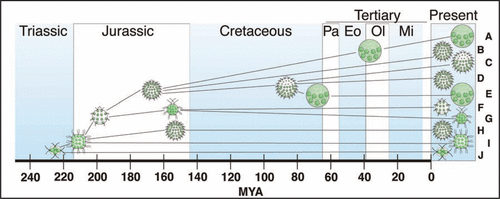Figures & data
Figure 1 Youngest estimates of first appearance of volvocine body plansCitation4 showing relatively rapid, early diversification of body plans (Triassic—Jurassic) and relative stability in most lineages thereafter (Cretaceous—Present). As an example of multiple origins, somatic cells had three independent origins: in Astrephomene (H), Volvox section Volvox (A), and the clade including Pleodorina and the remaining species of Volvox (C–E). Examples of reversals to ancestral traits include the reduction in ECM volume in the ancestors of Pandorina (G) and the loss of soma in one lineage of Eudorina (D). In (A, C, E and H), the smaller cells are somatic, while the larger cells are reproductive. (A and E) Volvox, with hundreds to tens of thousands of small somatic cells, a few much larger reproductive cells, and a large volume of ECM; (B and D) Eudorina, with 16–32 undifferentiated cells and a large volume of ECM; (C) Pleodorina, with 64–128 cells, ∼10–50% of which are somatic (in the anterior), and a large volume of ECM; (F) Volvulina, with 8–16 undifferentiated cells and a large volume of ECM; (G) Pandorina, with 8–16 cells and a small volume of ECM; (H) Astrephomene, with 32–64 cells, ∼3–6% of which are somatic (in the posterior), and a large volume of ECM; (I) Gonium, with 8–32 undifferentiated cells arranged in a flat or slightly curved plate; (J) Basichlamys, with four undifferentiated cells embedded in a small volume of ECM.Citation21–Citation23 Pa, Paleocene; Eo, Eocene; Ol, Oligocene; Mi, Miocene; MYA, Million years ago.
